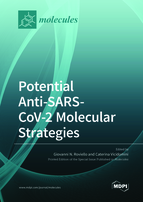Potential Anti-SARS-CoV-2 Molecular Strategies
A special issue of Molecules (ISSN 1420-3049). This special issue belongs to the section "Medicinal Chemistry".
Deadline for manuscript submissions: closed (31 December 2022) | Viewed by 56149
Special Issue Editors
Interests: bioinorganic chemistry; synthetic chemistry; nucleic acid chemistry; spectroscopic studies; computational studies; environmental chemistry
Special Issues, Collections and Topics in MDPI journals
Interests: pharmaceutical chemistry; neurodrugs; protein interactions; spectroscopy; computational chemistry; phytochemistry
Special Issues, Collections and Topics in MDPI journals
Special Issue Information
Dear Colleagues,
The COVID-19 pandemic, associated with the new virus SARS-CoV-2, has globally attracted the attention of the scientific community to the theme of coronaviruses (CoVs) and the prophylaxis and therapy of infections caused by the most pathogenic members of this family. In fact, while most CoVs are usually associated with mild symptoms such as those of the seasonal “common cold”, three CoVs have emerged in recent decades that can lead to severe pneumonia and in some cases death: SARS-CoV-1 (which caused SARS about 18 years ago), MERS-CoV (causing the highly fatal MERS in Middle East countries), and SARS-CoV-2 (associated with COVID-19). It is believed that CoVs are of zoonotic origin, and highly pathogenic members of their family could periodically emerge, leading to sanitary and consequent socio-economic impacts. Therefore, research on CoVs should be strengthened and encouraged even after, hopefully soon, the current pandemic is over.
In this Special Issue, we wish to focus on the area of novel anti-coronavirus drug discovery, design, and development, with the main interest, obviously, on the most pathogenic CoVs and in particular SARS-CoV-2 and MERS-CoV. However, contributions on other CoVs are also welcome as they could improve overall knowledge on the Coronaviridae. Other themes of interest are inherent in the development of vaccines against CoVs, and the investigation of the biomolecular processes targetable by anti-CoV strategies.
The issue is open to the submission of both original articles and reviews that describe research and ideas on themes around anti-CoV molecular strategies.
Dr. Giovanni N. Roviello
Dr. Caterina Vicidomini
Guest Editors
Manuscript Submission Information
Manuscripts should be submitted online at www.mdpi.com by registering and logging in to this website. Once you are registered, click here to go to the submission form. Manuscripts can be submitted until the deadline. All submissions that pass pre-check are peer-reviewed. Accepted papers will be published continuously in the journal (as soon as accepted) and will be listed together on the special issue website. Research articles, review articles as well as short communications are invited. For planned papers, a title and short abstract (about 100 words) can be sent to the Editorial Office for announcement on this website.
Submitted manuscripts should not have been published previously, nor be under consideration for publication elsewhere (except conference proceedings papers). All manuscripts are thoroughly refereed through a single-blind peer-review process. A guide for authors and other relevant information for submission of manuscripts is available on the Instructions for Authors page. Molecules is an international peer-reviewed open access semimonthly journal published by MDPI.
Please visit the Instructions for Authors page before submitting a manuscript. The Article Processing Charge (APC) for publication in this open access journal is 2700 CHF (Swiss Francs). Submitted papers should be well formatted and use good English. Authors may use MDPI's English editing service prior to publication or during author revisions.
Keywords
- Coronavirus
- SARS-CoV-2
- MERS-CoV
- COVID-19
- Antiviral drugs
- Vaccines
- Biomolecular targets
- RdRp
- Mpro
- Spike protein
- Anti-COVID-19 strategies
- Drug repurposing
- Natural products
- Synthetic antivirals








